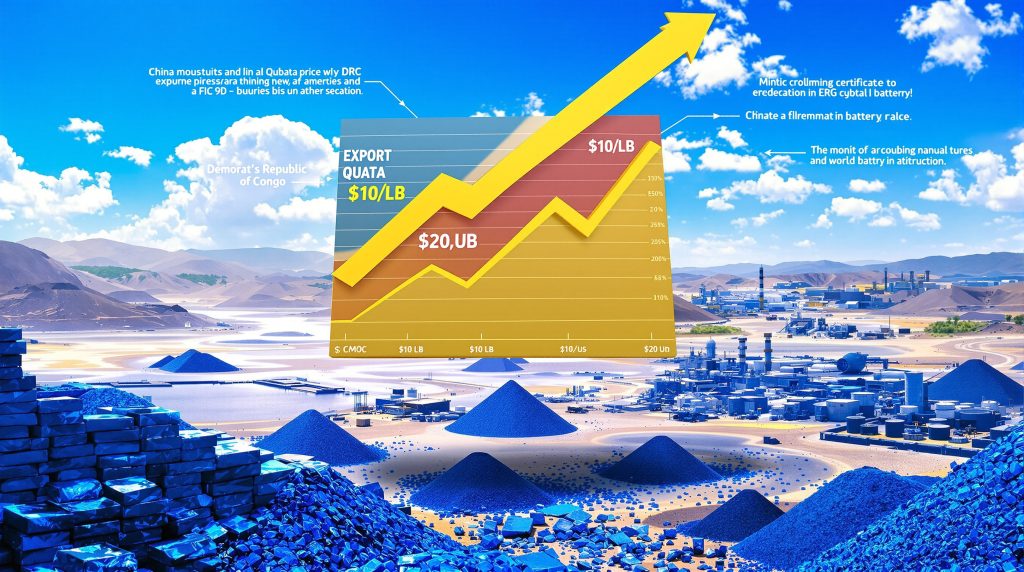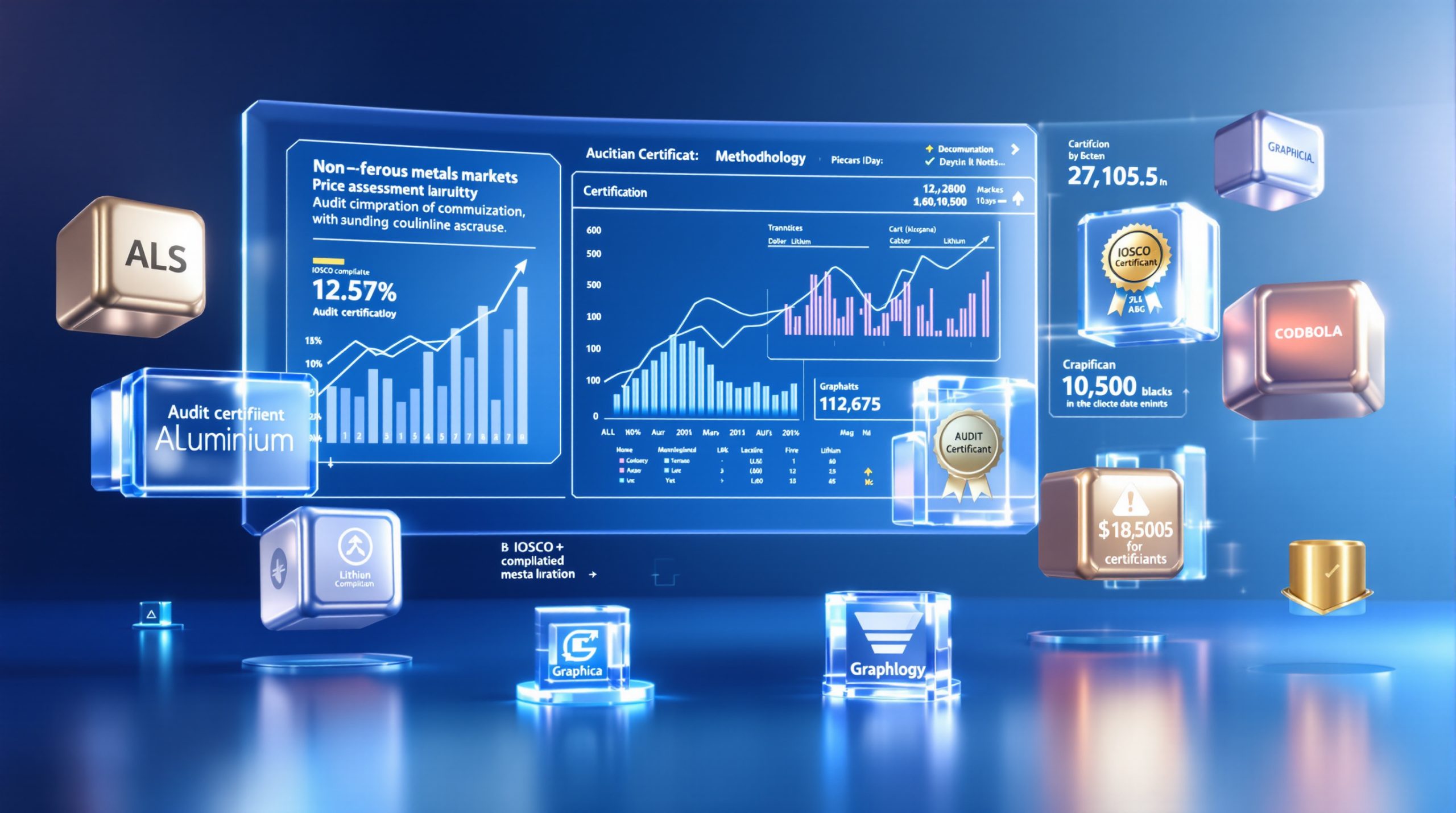Understanding the DRC's New Cobalt Export Regulations
The global cobalt market has undergone a seismic shift since early 2025, driven by strategic policy changes in the Democratic Republic of Congo (DRC). As the world's dominant supplier controlling approximately 75% of global production, Congo's decisions have sent ripples across international supply chains and created significant price volatility in this critical battery material sector.
What Prompted the DRC's Export Policy Changes?
Several factors converged to trigger Congo's dramatic shift in export policy. By early 2025, cobalt prices had plummeted to multi-year lows below $10 per pound—the lowest since 2015—due to market oversupply conditions. This price collapse threatened government revenues and highlighted the country's vulnerability to commodity market fluctuations.
President Felix Tshisekedi's administration recognized an opportunity to exert greater control over this strategic resource. According to cabinet meeting minutes from October 2025, Tshisekedi described the export restrictions as "a real lever" for Congo "to influence this strategic market, increase its revenues and improve the living conditions of its population."
Beyond immediate price concerns, the DRC government implemented these changes as part of a broader strategic initiative to capture more value from its mineral wealth through domestic processing—following models established by other resource-rich developing nations. The mining policy impact has been substantial, affecting both local operations and global supply chains.
Timeline of Export Restriction Implementation
The DRC's Congo cobalt export quotas strategy has unfolded in distinct phases:
• February 2025: The government imposed a complete export ban on cobalt products, effectively shutting off global access to three-quarters of the world's supply.
• October 16, 2025: Authorities announced a transition from the total ban to a more nuanced quota system.
• 2026-2027: Plans established for continued quota restrictions with potential adjustments based on market conditions and compliance.
• Long-term: Development of domestic processing capacity remains the ultimate objective, though analysts question whether the current approach will attract necessary investment.
The Structure of Congo's New Quota System
The transition from a total ban to a quota-based system represents a significant evolution in the DRC's approach to managing its cobalt resources. The new system introduces complex allocation mechanisms that have profound implications for major producers.
How Are Export Quotas Being Allocated?
The Congolese government has implemented a pro-rata distribution system based on companies' historical export performance from 2022 through 2024. This methodology has created clear winners and losers among major producers:
• CMOC Group: Received approximately 35% of the total allocation for the remainder of 2025, but faces severe restrictions compared to previous production levels.
• Glencore: Secured approximately 22% of the allocation through the end of 2025.
• Eurasian Resources Group (ERG): Granted approximately 12% of the allocation through the end of 2025.
• Smaller producers: The remaining percentage has been distributed among other operators based on their historical output records.
According to analysts at Citigroup, "The quota is lower than expectation for CMOC considering the recent ramp-up in cobalt output since 2022, while CMOC would benefit from hiking cobalt price after the quota policy."
Quota Volume Limitations and Timeframes
The new quota system imposes strict volumetric controls that dramatically reduce export potential:
• Remainder of 2025: Total allocation of 18,125 tonnes, distributed as 3,625 tonnes for October and 7,250 tonnes each for November and December.
• 2026-2027 annual quota: Set at 96,600 tonnes—less than 50% of 2024 production levels.
• CMOC's 2026 allocation: Limited to 31,200 tonnes, representing only 27% of their 2024 production from Congolese mines.
• Monthly distribution: The government has implemented a monthly allocation system to maintain market stability and prevent supply surges.
Market Impacts and Price Dynamics
The export restrictions have catalyzed dramatic price movements across cobalt markets, reversing years of decline and creating new market dynamics for this critical battery material.
How Have Cobalt Prices Responded to Export Restrictions?
The market response has been immediate and substantial:
• Price surge: Nearly 100% increase since pre-ban levels, rising from under $10 per pound to nearly $20 per pound by October 2025.
• Cobalt hydroxide: This intermediate product has experienced even more dramatic gains, with prices more than tripling since restrictions began in February 2025.
• Wuxi Stainless Steel Exchange: Trading data shows consistent gains, with cobalt metal up approximately 2% following the quota announcement in mid-October 2025.
• Price forecast: Market analysts, including Macquarie Group, have suggested potential for prices to exceed the previous bull market levels seen in 2022 if quota enforcement remains strict.
This price volatility has had cascading effects on stock valuations for major producers. While CMOC Group saw its shares drop as much as 7.2% in Shanghai trading following the quota announcement, other cobalt producers like Zhejiang Huayou Cobalt rose more than 2%, highlighting the uneven impact across the industry.
Supply-Demand Imbalance Projections
Market analysts have identified concerning supply gaps on the horizon:
• Macquarie Group projects that "the market would run out of material before the middle of 2026" if quotas are strictly enforced.
• Chinese refined output has already fallen to multi-year lows as processors struggle to secure feedstock.
• Alternative sourcing efforts, while accelerating, remain insufficient to cover the potential shortfall from Congolese restrictions.
• Stockpile depletion is accelerating among downstream users, particularly battery manufacturers and automotive companies with electric vehicle production commitments.
Global Supply Chain Disruptions
The dramatic shift in export policy has triggered complex adaptations throughout global cobalt supply chains, with Chinese refiners particularly affected given their dominance in processing.
How Are Chinese Refiners Adapting to Limited Feedstock?
Chinese refiners, who traditionally dominate global cobalt processing, have been forced to implement multiple adaptation strategies:
• Import collapse: Chinese imports of intermediate cobalt products fell by over 90% year-over-year in August 2025, according to customs data.
• Alternative processing: Roman Aubry, analyst at Benchmark Mineral Intelligence, notes that refiners are shifting to new methods—buying refined metal to dissolve directly into battery-grade cobalt sulfate, bypassing the hydroxide intermediate step.
• Indonesian sourcing: Interest in Indonesian cobalt resources has intensified as companies seek alternative supply sources.
• Production curtailment: According to Thomas Matthews, battery materials analyst at CRU Group, "Refined output is already being curtailed to preserve intermediate stocks," with Chinese metal production falling to multi-year lows.
Alternative Sourcing Strategies Emerging
As the DRC's restrictions continue, multiple alternative strategies are being deployed:
• Indonesian production expansion: As the world's second-largest producer, Indonesia is positioned to increase market share, though volumes remain insufficient to replace Congolese supply.
• Recycling acceleration: Battery recycling initiatives have gained momentum, with companies intensifying efforts to recover cobalt from end-of-life batteries.
• Chemistry adjustments: Battery manufacturers are accelerating research into reduced-cobalt or cobalt-free formulations, though commercial-scale transitions face technical challenges.
• Informal channels: Analysts at Darton Commodities have warned of "the risk of informal trade or off-quota leakage" as financial pressures mount on producers with stockpiles trapped within the DRC.
Strategic Implications for Battery Supply Chains
The cobalt supply shock comes at a critical time for global electric vehicle markets, creating complex strategic challenges for battery manufacturers and automakers.
What Does This Mean for EV Battery Production?
The restrictions have triggered multi-faceted responses across the battery industry:
• Cost pressures: With cobalt prices nearly doubling and potential for further increases, manufacturers face new cost calculations for cobalt-containing batteries.
• Chemistry acceleration: Research into reduced-cobalt chemistries has gained urgency, with companies potentially accepting performance trade-offs to reduce supply risk.
• Supply chain reevaluation: Automakers are conducting comprehensive risk assessments of battery material supplies, with some considering vertical integration strategies.
• Inventory management: Strategic stockpiling behavior has emerged among battery manufacturers attempting to secure supply continuity for production commitments.
China, as the world's largest EV market and dominant battery manufacturing hub, faces particular challenges adapting to these new constraints while maintaining ambitious electric vehicle production targets.
Investor Sentiment and Market Reactions
Financial markets have responded quickly to the shifting landscape:
• CMOC share price dropped 7.2% following the quota announcement, reflecting concerns about restricted export volumes.
• Other cobalt producers have seen share price increases, with Zhejiang Huayou Cobalt gaining more than 2% as higher prices benefit companies with access to non-DRC supply.
• Macquarie Group has named cobalt among its "most preferred" commodities for the next six to nine months, anticipating continued price strength.
• Market volatility expectations have increased, with analysts projecting supply uncertainty through at least 2026.
The DRC's Strategic Objectives
Behind Congo's policy shift lie multiple strategic objectives that reflect both economic pragmatism and longer-term development ambitions.
How Will Export Quotas Benefit the Congo?
The DRC government has articulated several expected benefits from the new export regime:
• Revenue enhancement: Higher global prices should increase government revenues from royalties and taxes, even with reduced export volumes.
• Investment leverage: The restrictions create incentives for mining companies to invest in domestic processing capacity.
• Strategic control: By managing supply of a critical battery material, Congo gains geopolitical leverage in an increasingly electrified global economy.
• Economic development: The government has explicitly linked these policies to improving living conditions for its population, though the mechanisms for this remain unclear.
President Tshisekedi described the export restrictions as "a real lever" for Congo to increase its revenues and improve living conditions, highlighting the domestic political dimensions of the policy.
Enforcement Mechanisms and Compliance
The government has established strict compliance mechanisms:
• "Exemplary sanctions" have been threatened against any actors involved in fraudulent activities, including permanent exclusion from the quota system.
• Monitoring systems are being implemented by regulatory authorities to track production and export volumes.
• Cabinet meeting minutes from October 3, 2025 indicate a zero-tolerance approach to violations.
• Despite these measures, analysts have noted risks of informal or illegal export channels developing as financial pressures mount on producers.
Industry Response and Adaptation Strategies
Mining companies and downstream users have been forced to develop complex adaptation strategies in response to Congo's export policies.
How Are Mining Companies Responding?
Major producers face difficult operational decisions:
• Stockpile accumulation: Continued production without corresponding export permits is creating growing stockpiles within the DRC.
• Financial pressure: Darton Commodities has warned of "financial strain on producers" as the mismatch between production and export capabilities continues.
• Investment evaluation: Companies are reassessing the viability of processing investments within Congo, weighing regulatory uncertainty against potential benefits.
• Portfolio diversification: Major mining companies are reevaluating global cobalt project portfolios, with increased interest in assets outside the DRC.
The disparate impact of quotas has created competitive imbalances, with CMOC Group particularly constrained relative to its recent cobalt project expansion.
Battery Manufacturer Contingency Planning
Downstream users have implemented multiple risk mitigation strategies:
• Supply diversification: Battery makers are actively seeking alternative supply sources where feasible.
• Technical adaptation: Accelerated research into material efficiency improvements and alternative formulations has gained priority.
• Chemistry exploration: Development of cobalt-reduced battery chemistries has accelerated, with some manufacturers willing to accept performance trade-offs.
• Inventory management: Strategic stockpiling has increased among manufacturers with sufficient capital resources.
Long-Term Market Outlook
The long-term implications of Congo's export controls remain uncertain, with multiple factors that could influence market outcomes through the latter half of the decade.
Will the Congo's Strategy Create Sustainable Market Balance?
The sustainability of the new quota system depends on several factors:
• Market alignment potential exists if quotas correctly anticipate global demand growth, potentially creating more stable pricing.
• Substitution risk increases as higher prices and supply uncertainty drive research into alternatives, potentially undermining long-term demand.
• Investment uncertainty may hamper development of domestic processing capacity, contradicting one of the policy's core objectives.
• Informal exports could potentially undermine the system's effectiveness if enforcement proves inadequate.
Darton Commodities has questioned whether "the country's punitive and unpredictable regulatory approach will inspire the confidence required for such long-term investments" in domestic processing capacity. The broader industry evolution trends suggest companies will continue diversifying their supply chains in response.
Investment Climate Implications
The policy shift has created a complex investment landscape:
• Regulatory uncertainty has increased risk premiums for DRC mining operations.
• Capital allocation decisions face additional complexity, particularly regarding processing investments within Congo.
• Projects outside the DRC have gained relative attractiveness, despite typically lower grades or higher costs.
• Recycling and circular economy solutions have attracted increased investment interest as supply diversification strategies.
Investors seeking exposure to the sector would benefit from reviewing a comprehensive investing strategies guide to navigate these complex market dynamics.
FAQ: Congo Cobalt Export Quotas
What percentage of global cobalt comes from the DRC?
The Democratic Republic of Congo accounts for approximately 75% of global cobalt production, making it the dominant supplier to world markets. This concentration has magnified the impact of export policy changes on global supply chains.
How long will the Congo's quota system remain in place?
Current plans indicate quotas will remain through at least 2027, with allocations for 2026-2027 already established at approximately 96,600 tonnes annually. The government has positioned this as part of a longer-term strategy to develop domestic processing capacity.
Which companies are most affected by the export quotas?
Major producers including CMOC Group, Glencore, and Eurasian Resources Group are most significantly impacted, with CMOC facing the largest proportional reduction compared to recent production levels. CMOC's 2026 allocation of 31,200 tonnes represents only 27% of their 2024 production from Congolese mines.
How might cobalt prices trend through 2026?
Analysts project continued price strength with potential to exceed previous bull market highs from 2022 if quota enforcement remains strict and alternative supplies cannot fill the gap. Macquarie Group has stated that "the market would run out of material before the middle of 2026" if quotas are strictly enforced.
The cobalt market will likely continue experiencing significant volatility as global supply chains adapt to this new regulatory reality while battery demand continues to grow with electric vehicle adoption. Furthermore, the development of a European critical materials facility may provide some supply diversification in the long term.
Ready to Spot the Next Major Mineral Discovery?
Stay ahead of the market with Discovery Alert's proprietary Discovery IQ model, which delivers real-time notifications on significant ASX mineral discoveries, turning complex data into actionable investment insights. Explore historical examples of exceptional returns from major discoveries by visiting our dedicated discoveries page and begin your 30-day free trial today.




